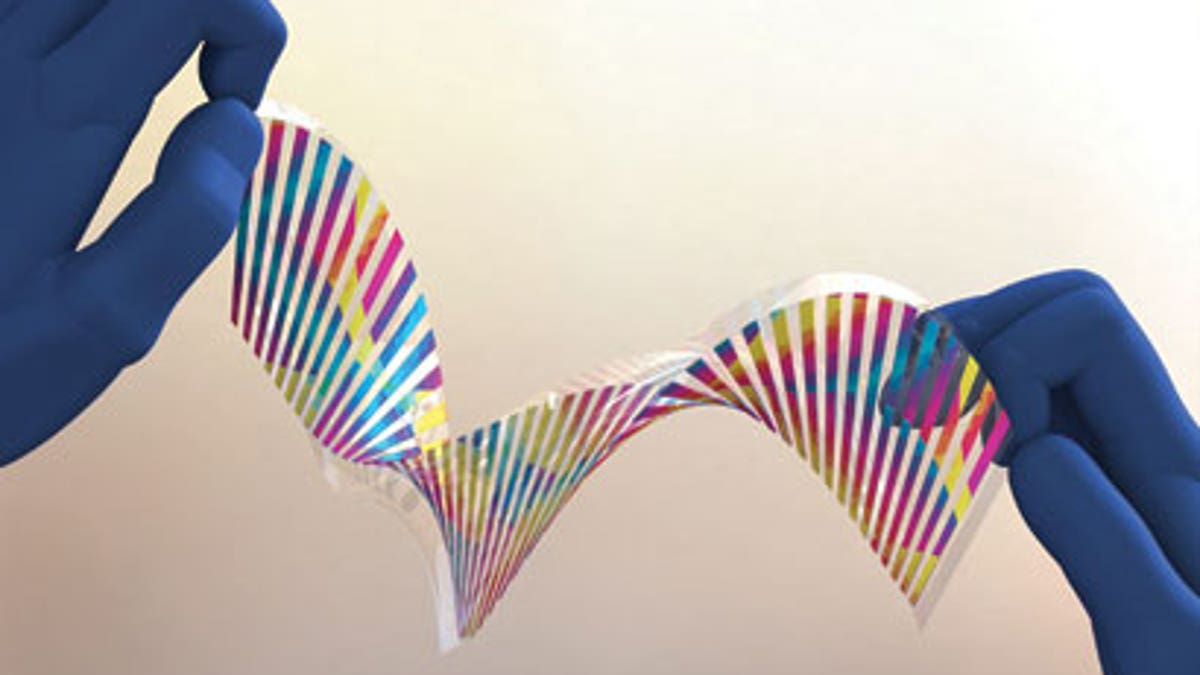
(Image courtesy of Connie Chang-Hasnain)
Taking a cue from a certain color-shifting lizard, researchers at the University of California at Berkeley have created a new super-thin material that can change color on demand. The new technology could open up a new world of display possibilities, from adaptable military vehicle camouflage to brilliant color presentations for outdoor venues. “Although we are still in the early stage of process/fabrication development,” study author and team leader Professor Connie J. Chang-Hasnain said, “I am optimistic that some form of this technology should reach the public domain soon.”
The material is made by etching tiny ribbons onto a layer of silicon (a thousand times thinner than a human hair) within a flexible sheet of film, and can change colors simply by being flexed or bent. The team has worked with silicon ribbons since 2003, but it was only 9 months ago when they decided to take their work in a more colorful direction. “We are intrigued by how chameleons and some other animals could change their colors,” Chang-Hasnain told FoxNews.com. “And we thought we would give it a try to see if we can design our silicon ribbons to do that.”
It was recently reported that chameleons are able to shift colors by changing the spacing of nanocrystals under their skin, which then affects the way the latter reflects light. Similarly, it is the spacing in the silicon ribbons that gives the new synthetic skin its color-changing abilities: when the light hits the spacing, this distance between the ribbons designates the wavelength of light reflected back.
“The way it works is to leverage the large refractive index contrast in the ribbon and its surrounding to introduce an interference effect on optical waves impeding upon the surface,” Chang-Hasnain explained. “The interference effect is very power-efficient due to the index contrast, leading to vivid color with very thin ribbons. The change of the spacing between the ribbons changes the wavelength/color with strong constructive interference, and hence changes the color of the surface.” She adds that older color-shifting materials were thicker and didn’t have the flexibility of the new technology. “In addition, different thicknesses are required for different colors. It would be quite challenging to have multiple colors all on the same flat surface,” she said. “In our case, we use the same ribbon thickness and only change the width of ribbon for different colors, making it easy to display a wide range of colors on the same flat surface.”
There are many possible uses for the new “chameleon skin.” In addition to the aforementioned camouflage and presentation possibilities, the technology could also be used for construction and medical purposes. “More day-to-day applications could include sensors that would change color to indicate that structural fatigue was stressing critical components on bridges, buildings, or the wings of airplanes,” Chang-Hasnain said. “Wearable bio- and medical sensors could be another application so people can monitor their pulses and other stress markers more easily.” Also, Spiderman may have some competition, as full-on “chameleon” suits could become available as well.
So when can we see this cool new tech? According to Chang-Hasnain, it won’t be long. “Although we are still in the early stage of process/fabrication development, I am optimistic that some form of this technology should reach the public domain soon.”




















